Instructions for planting dill seeds in open ground for beginner gardeners
Dill is one of the most popular spices. They love it not only for its taste and aroma, but also for its ease of growing. However, the cultivation of this plant has its own nuances.
From the article, you will learn how to grow dill from seeds, how to properly prepare seeds and soil for planting, how to care for dill in the open field to get a good harvest.
The content of the article
The timing of sowing dill in open ground
In one season, dill manages to produce a crop several times, so the plant is planted from spring to late autumn.
Attention. In spring and autumn, dill is grown to obtain fragrant herbs, in summer - to obtain umbrellas.
Dill seeds tolerate frosts well, so they are sown after the snow melts, when the air temperature rises above + 3 ... + 5 ℃ - from early April to mid-May, depending on the region. In summer they are planted in any of the months.
Reference. To keep fresh, fragrant greens on your table all summer long, sow dill seeds every two weeks.
In the fall, seeds are planted from October to November. Winter planting is done to get fresh greens in the spring before two weeks.
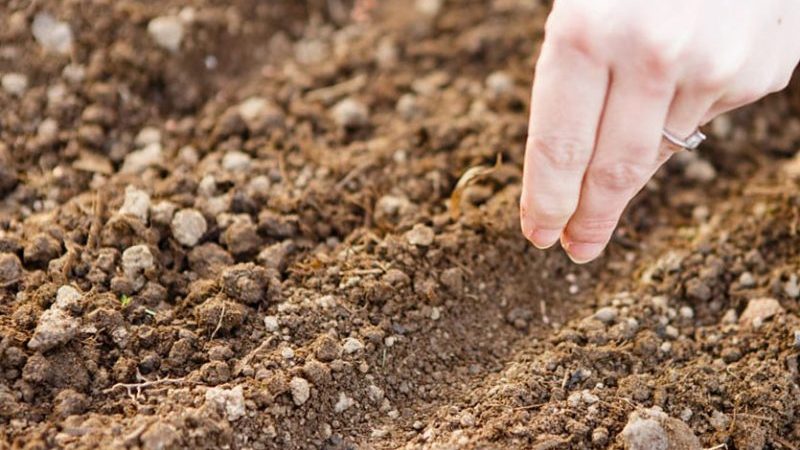
Lunar landing
What days in 2019 is it best to sow dill:
- July: 10-12, 20-22, 29-31;
- August: 2-8, 11-13, 17-18, 21-23, 26-31;
- September: 1-5, 7-10;
- October: no;
- November: 1-3, 6-8, 15-18, 24-25.
Unfavorable days:
- July: 2, 3, 17;
- August: 15, 16, 30, 31;
- September: 14, 15, 28, 29;
- October: 14, 28;
- November: 12, 13, 26, 27.
Choose the days for planting in advance so that the seedlings are strong.
Preparatory stage
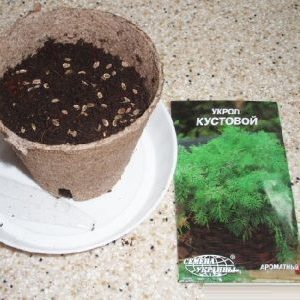
Each plant has certain conditions necessary for growth and development. Preparing the soil and dill seeds responsibly can help you harvest faster and improve quality.
Soil preparation
Dill loves to grow in a sunny garden bed or in partial shade. Choose a location that does not stagnate water, but that is not too dry.
If in the previous year cucumbers, tomatoes, cabbage, beets or legumes grew on the chosen bed, then fertilizing the soil is not necessary. Dill has enough nutrients left over from last year. Don't plant it after carrots, celery, parsley, and dill itself.
Good neighbors for a spicy crop are cucumbers, zucchini, cabbage and tomatoes. They are often planted together, but not too close to the stems of the plants so that the dill does not take water and nutrients from them.
To prepare the soil for planting, humus is introduced in the fall in the amount of 3 kg per sq. m or any complex fertilizer. Then the land on the site is carefully dug to a depth of 20-30 cm and leveled with a rake. In the spring, wood ash is added to the soil 0.1-0.2 kg per square meter. m.
Important. For better seed germination, it is useful to fertilize the soil with superphosphate in an amount of 30 g per sq. m.
Seed preparation
Dill seeds are rich in essential oils. These oils prevent germination, as moisture does not penetrate into the seeds. To improve the germination of dill, the seeds are poured with warm water and left for two days. The water is changed as it cools.
After that, the dill seeds are wrapped in a damp cloth and left for 2-4 days at room temperature until they sprout.
Preliminary preparation of seeds prevents the plant from diseases.Therefore, after soaking, the seeds are washed with a strong solution of potassium permanganate, then running water and then dried.
How to sow dill correctly
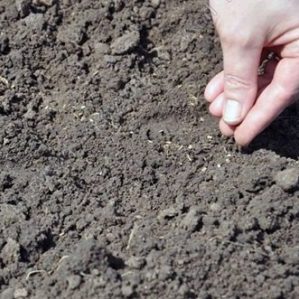
After preparing the soil and seeds, they proceed directly to sowing dill.
- In the garden, rows are made with a depth of 1.5-2 cm.
- Leave 20 cm between the rows.
- The resulting rows are watered.
- Seeds are sown every 5 cm.
- Sprinkle on top with the same soil.
Dill can also be sown using a carpet pattern. The seeds are evenly scattered over the soil surface, leveled with a rake and watered.
Features of planting in the cold season
During planting, before winter, the seeds are sown 2 cm deeper than in spring. Therefore, dill is planted before the soil freezes. The optimum air temperature will be -5 ... 0 ℃, but not higher than + 3 ℃, so that the seeds do not germinate until spring. Another important point: during winter planting, the soil is not watered.
Alternative landing method:
- prepare a bed;
- planting material is scattered over the surface;
- cover the top with soil with humus at the rate of a bucket of humus per 1 sq. m.
As the snow melts in the spring, the seeds will go deeper and begin to germinate.
Care after landing
Despite its unpretentiousness, dill needs proper care. Providing a plant with a comfortable environment will surely delight you with a bountiful harvest.
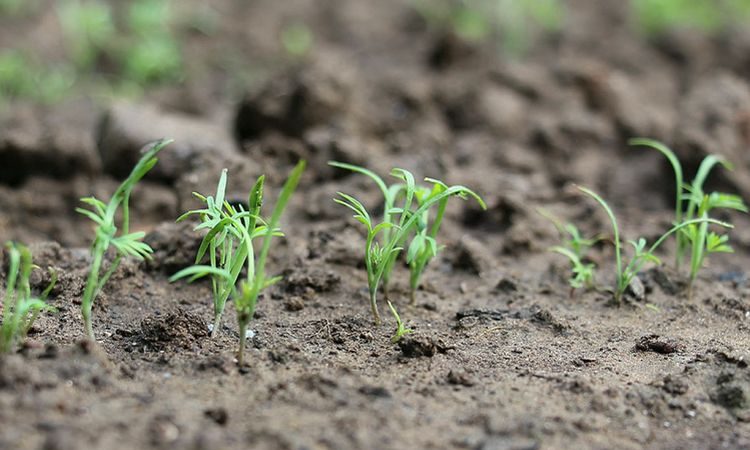
Watering
Do not overdry the soil in the dill garden; it should always be slightly damp. But do not turn the garden into a swamp, otherwise the plant will get sick and die. Drought is also harmful to the development of dill - the leaves will turn yellow, dry out and become unusable for food. It is best to water green spaces 2 times a week at 6-8 liters per sq. m in dry weather.
Top dressing
For dill with a short ripening period, the soil can not be fertilized, the plant will have enough what was introduced during the preparation of the garden... If dill grows slowly, it is fertilized with nitrophos or urea (10-15 g / sq. M). The same fertilizers are applied during the first feeding mid-ripening and late-ripening varieties, when they have 2-3 leaves.
After 20-25 days, they are fed with potassium salt and urea (carbamide) at the rate of 3-4 sq. 15 g and 20 g of fertilizers, respectively. Make sure that fertilizers do not get on the leaves, and thoroughly water the beds after feeding.
Weeding and loosening
So that the nutrients do not go to the weed grass, but get useful greens, the garden is weeded. In addition, the weed root system compacts the soil and retains excess moisture.
Dill loves breathable soil. To ensure full air exchange, the soil is loosened between the rows after rain or watering.
Thinning
For normal growth, dill thickets are thinned out if bushes grow too thick. The distance between them after thinning is left 3-5 cm at growing for greens and 8-10 cm each - for salting and obtaining seeds.
Shelter in the heat
Because of the scorching sun, dill leaves turn yellow and dry out. Cover the garden with a canopy to save the greenery.
Pest control
Aphids, umbrella moth and earthen flea are the most common pests of dill. An infusion of potato tops with laundry soap helps from aphids. For flea beetles, use Fitosporin solution.
Council. Remove weeds from the site in time, and there will be an order of magnitude less pests.
Diseases
Due to improper care, the plant becomes sick. The most common diseases of dill:
- Downy mildew manifests itself whitish bloom on the leaves, for prevention, the plant is pollinated with sulfur, and diseased bushes are treated with potassium permanganate or a mixture of antibiotics - they take penicillin, streptomycin and terramycin in equal parts.
- Rust fungus - the plant is covered with brown spots. For treatment, the plant is sprayed with Bordeaux liquid 3 times a month.
- Fomoz - black spots appear on the leaves and shoots. To save, the affected areas are removed, and the plant is treated with Bordeaux liquid.To protect healthy bushes, the preparations "Fitosporin", "Trichodermin" and "Mikosan-V" are used.
The most effective method of control is prevention: remove affected plants and weeds in time, observe crop rotation, process seeds before planting.
Good advice and mistakes to avoid
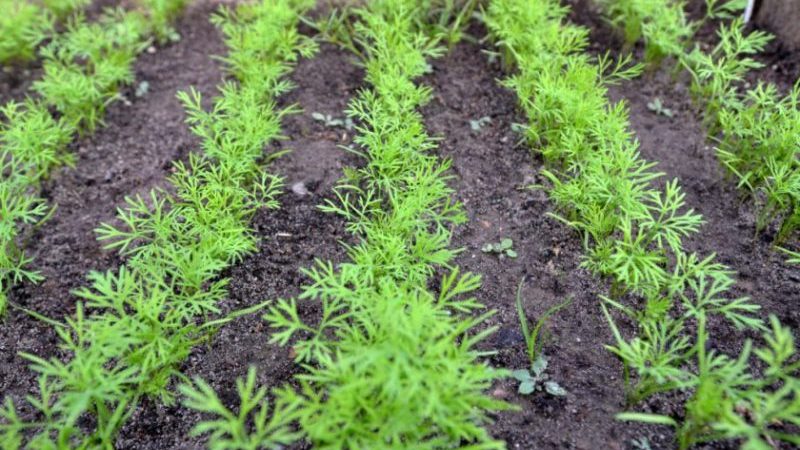
Novice gardeners will need advice from more experienced colleagues:
- if you buy dill varieties of various ripening periods, you can enjoy fragrant greens until late autumn, for example, Gribovsky, Dalny - early ripening, Alligator, Kusty - mid-season, Salute, Buyan - late varieties;
- before sowing, fill the seeds with vodka for a few minutes, it will dissolve the essential oils, and the seeds can be sown immediately;
- carrots, caraway seeds, parsley are bad neighbors for dill;
- do not water the dill immediately after sowing, so that the seeds do not sink lower than necessary;
- in the spring in the evenings, if frosts are expected, the winter dill is covered with a film or covering material, fixing it along the edges;
- harvest early in the morning so that the leaves do not have time to wilt in the sun;
- the collected greens are stored in the refrigerator for a week to preserve the dill for the winter, it is dried or frozen.
Conclusion
Growing dill is a simple procedure. Be sure to take time to seed treatment and soil preparation, water the greens on time, feed fertilizers. Subject to all the conditions for planting and care, you will receive a rich harvest that will delight you not only in summer, but also in winter.